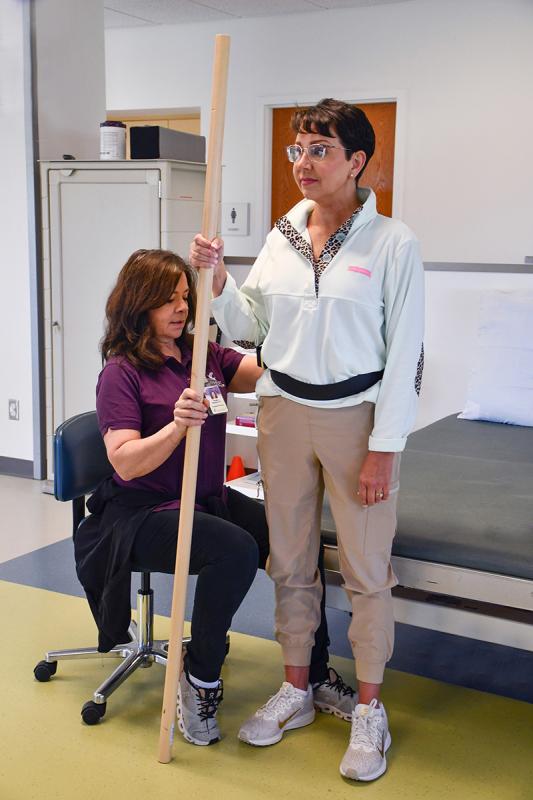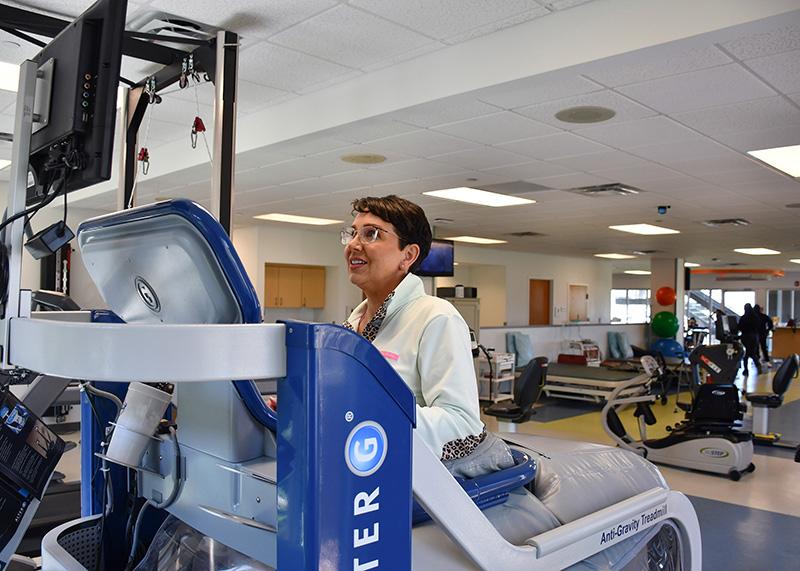When she heard she had breast cancer last year, Lori Gray of Brandon could have felt cursed.
She’d already spent four-plus years with a disabling illness that doctors struggled to diagnose. So the last thing she needed was a new medical battle.
But it turns out her bad luck had a bright side. “It took me getting cancer to get to the right physical therapist,” she explained.
That physical therapist is Teresa Swyers of Methodist Outpatient Therapy in Flowood. She’s known for using hands-on, myofascial release techniques to ease pain and range-of-motion restrictions both before and after mastectomies.
Yet it was her expertise in neuro-rehab that helped Gray overcome the impact of her original illness. As Swyers evaluated Gray for therapy, she recognized symptoms ordinarily seen in patients with neurological conditions.
Gray arrived on a walker, due to problems with balance, strength and endurance. “She also had neuropathy in her feet, double vision, nerve palsy, lower extremity circulation issues … and the list goes on,” Swyers said.
Or as Gray quips: “It might be easier to list what I haven’t had.”
Before her illness, Gray said she was in the best shape of her life. “I did Pilates and yoga, and I was eating right,” she said. “I was so strong. I was that woman in high heels running up and down stairs at my office. I had too many things to do to slow down. Then God made me slow down.”
Gray believes her downfall began on Oct. 31, 2017, the day she got a flu shot. Within a few days, she experienced flu-like symptoms, followed by a strange array of ailments. She had a metallic taste in her mouth, numbness and tingling on the right side of her face, distorted vision and ringing in her right ear.
“Then on my birthday, Dec. 11, all the sensations went to the other side,” she said. “Everything started getting worse. I developed horrid pain in my right hip, and my gait all of a sudden changed. I remember vividly shuffling my feet and my balance being off.”
Doctors responded with a litany of tests. Gray would undergo nine MRIs and two nerve conduction studies. After every one, she was told the results were “perfect.” She didn’t have multiple sclerosis (MS) or amyotrophic lateral sclerosis (ALS). But a definitive diagnosis remained elusive.
Initially, Gray was prescribed anti-viral drugs and steroids, which provided minimal relief. Next, came intravenous immunoglobulin therapy (IVIg). She got IV injections of infection-fighting proteins made from a pool of thousands of healthy donors.
It’s a common treatment for Guillain-Barré syndrome (GBS), which was eventually deemed the likely cause of Gray’s decline. The Centers for Disease Control says the rare neurological disorder happens when the immune system mistakenly attacks part of the peripheral nerve system—the network of nerves located outside of the brain and spinal cord. Symptoms can range from brief weakness to nearly complete paralysis.
In rare cases, vaccinations have increased the risk of GBS. But the CDC says it’s more likely for people to get GBS after the flu itself.
GBS strikes only one or two people per 100,000. But Methodist Rehabilitation Center staff members know it well. As Mississippi’s only hospital that specializes in rehabilitation medicine, MRC has long attracted GBS patients from across the state. Those who live close enough, typically move on to Methodist Outpatient Therapy in Flowood or Ridgeland to continue their recovery.
Most fully bounce back. But Gray’s prolonged search for a proper diagnosis delayed her therapy. By the time she came to Methodist, life as she knew it was lost. She’d had to give up driving and retired from her job as a paralegal.
She ended up in Swyers’ care because her cancer surgeon prescribed pre-mastectomy therapy to address a case of frozen shoulders. “It’s when you can only lift your arms to shoulder height because you’ve lost joint mobility” explained Swyers.
“It was so painful,” Gray said. “I couldn’t wash my own hair or get in and out of the bathtub. I couldn’t get milk out of the refrigerator. I became completely dependent on my husband and two sons. My sons were putting my hair in ponytails.”
With the blessing of Gray’s doctor, Swyers also provided additional therapy for “all the issues that had been going on since 2017.” Gray began a regimen to improve her upper and lower extremity weakness, gait abnormalities, balance, joint mobility and range of motion.
In neurological therapy, the now 48-year-old Gray addresses tightened muscle tone that causes stiff or rigid movements. She also works on her lack of proprioception, the ability to sense the location, movement and action of body parts. Her orthopedic therapy focuses on joint mobilization, strengthening and flexibility.
On a recent therapy day, Gray walked 20 minutes on Methodist’s Alter-G Anti-Gravity Treadmill. The device off-loads as much as 80 percent of a user’s body weight, creating a low-impact workout zone. And it has helped Gray begin walking with a cane.
“It feels so good be upright,” she said. “I can close my eyes and imagine myself walking around the neighborhood like I used to do. It’s one of my favorite things because it helps me feel independent.”
She also savors sessions in Methodist’s SwimEx therapy pool. It provides a space where Gray can work out on an underwater treadmill or exercise against an adjustable current and not worry about falling.
“Her balance is dramatically different in the pool than on the land,” said physical therapist assistant Carly Novak.
Gray said the benefits of the pool are as much mental as they are physical. “Just the freedom and to feel like you are doing something normal—for my mind and heart, that’s so important,” she said.
In addition to Swyers and Novak, Gray’s caregiving team includes physical therapist Lana Bernier. She is certified in the rehabilitation of the vestibular system, which includes organs involved in balance, posture, movement and spatial orientation.
Gray had fallen twice, and was afraid of falling again. So Bernier was tasked with getting to the root of her unsteadiness.
As she evaluated Gray—who has to wear prism glasses to battle double vision—Bernier could see that her vision problems were impacting her balance. “To look left, she tends to move her whole head, which can throw off her balance,” Bernier said. “We’re working on a more functional eye range.”
Gray also recently visited Methodist Physical Medicine, where rehab medicine physician Dr. Philip Blount gave her Botox injections to relax her curled-under toes.
Gray is not surprised that her recovery has required a diverse care team and some creativity. “Nothing about me is textbook. Everybody is having to make things up as they go,” she joked.
Gray had to pause her therapy twice as she underwent a mastectomy, followed later by a hysterectomy. “I was supposed to have a six-week break, but I came back in four weeks because I needed to get better,” Gray said. “I conquered the cancer, and I believe I can walk.”
Her diligence is paying off. “Her center of gravity has improved, and her shoulders are almost within normal limits,” Swyers said. “All her leg strength is improving, and her movement patterns are becoming more normalized.”
“I’m driving again because I now have more movement and control of my hands and feet,” Gray added.
While she’s been helped by a number of caregivers, Gray said it was Swyers who gave her the confidence to persevere.
“Teresa said: ‘We can get you to walk.’ And I said: Really? I honestly thought my life was going to be one of disability. She’s the first medical professional I’ve been in touch with in five years who has told me: ‘We can get you through this. You can recover.’ I really needed to hear that. When you believe you can, I think you will.’”



